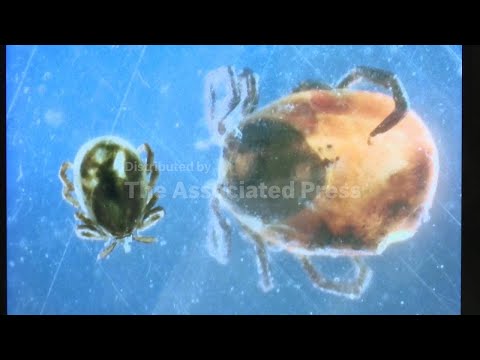(9 Sep 2025)
RESTRICTION SUMMARY:
ASSOCIATED PRESS
East Stroudsburg, Pennsylvania – 9 September 2025
1. Various of Nicole Chinnici looking at ticks through a microscope
2. Two blacklegged ticks or deer ticks on screen
3. Close up of the blacklegged tick nymph stage
++ PARTIALLY COVERED++
4. SOUNDBITE (English) Nicole Chinnici, Director of Tick Research Lab of Pennsylvania,
East Stroudsburg University:
“This year, we like to say it’s a little tickier than past. And we did experience an increase in the number of ticks that we received for testing. Our most common tick that we get here in the Northeast and Pennsylvania is the blacklegged tick, which is associated with the majority of the tick-borne illnesses that we see in the human population in cases in humans such as Lyme disease, babesiosis, anaplasmosis. We’ve been seeing an increase in American dog ticks, as well as the Asian longhorned and the lone star tick in our state of Pennsylvania.”
5. Mid of drop box at the Tick Research Lab
6. Close of a bottle contained Asian longhorned ticks
7. Mid of Asian longhorned tick
8. Close up of Asian longhorned tick’s eggs
++ PARTIALLY COVERED++
9. SOUNDBITE (English) Nicole Chinnici, Director of Tick Research Lab of Pennsylvania,
East Stroudsburg University:
“One interesting fact about the Asian longhorned tick in comparison to our other tick populations that we have, it’s parthenogenic, which is a very fancy name for it can reproduce without mating. So, we don’t have male ticks in the United States, we just have the females. So when she gets her full blood meal, she will produce viable eggs and those will hatch into larval ticks. So, they are very quick spreading. They tend to infest livestock, so livestock trade or movements. But we have seen a decent number of them also now attaching to humans, as well as companion animals, such as your dog or your cat or things like that."
10. Close up Chinnici moving specimen in bag
11. Chinnici looking at picture of Asian longhorned tick on screen
12. Close up of Asian longhorned tick on screen
++ PARTIALLY COVERED++
13. SOUNDBITE (English) Nicole Chinnici, Director of Tick Research Lab of Pennsylvania,
East Stroudsburg University:
“So right now, our biggest concern is with livestock. So, because they’re pathogenic and they tend to have a preference currently for livestock animals, so cattle, things like that, they can cause infestation on these animals. So, it could lower their immune system and put them at greater risk for other diseases. So, it could have an impact on our beef industry and the cattle and livestock across the United States. So that is one concern. But as their population increases, because they lay thousands of eggs, if they do start to pick up these tick-borne illnesses, because now they’re becoming more of a generalist and they’re feeding on other organisms, if they start to feed on organisms that do transmit diseases to ticks, so are reservoirs in the population, then they’ll start to pick up these pathogens and there will be a spillover event eventually to humans. So understanding this now and early so that we can maybe get ahead of it is important so that we’re not chasing it down like we were the first time around with blacklegged ticks and Lyme disease.”
14. Various of displays of ticks in bottles
STORYLINE:
Expert warns that this year’s tick season is proving to be “tickier” than last year.
The Asian longhorned tick was first confirmed in the United States in New Jersey in 2017 and it has since spread to more than 20 states, clustering mostly around the eastern third of the country.
Find out more about AP Archive: http://www.aparchive.com/HowWeWork
Twitter: https://twitter.com/AP_Archive
Facebook: https://www.facebook.com/APArchives
Instagram: https://www.instagram.com/APNews/
You can license this story through AP Archive: http://www.aparchive.com/metadata/youtube/e65eb3a6538c4bcd8f65e15c8a5e4b5d
Author: AP Archive
Go to Source
News post in September 15, 2025, 12:04 am.
Visit Our Sponsor’s:
News Post In – News





